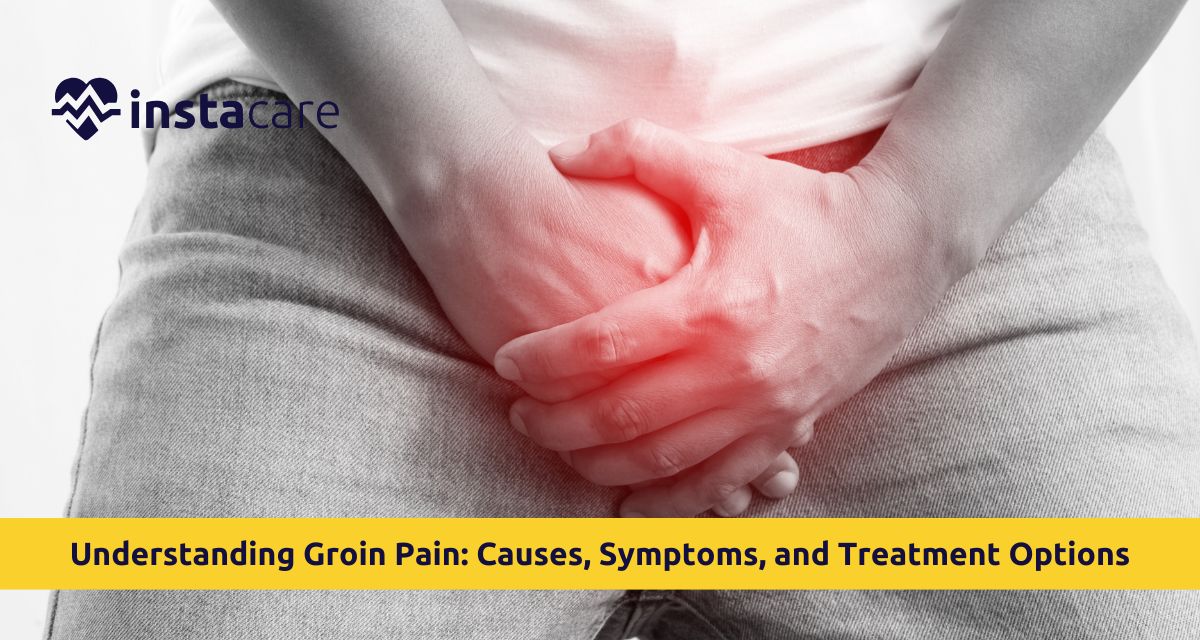Groin pain can significantly impact your day-to-day comfort, mobility, and quality of life. Whether you’re an athlete dealing with a sports injury or an individual experiencing unexplained discomfort in the groin region, it’s important to understand the causes, warning signs, and treatment options available.
This is a query for What is groin? it’s pain, signs and symptoms, how to diagnose it, and how to cure it best. From hernias to lymph nodes and groin strain, determining the cause is where it all begins to repair it and obtain lasting relief.
What is Groin Pain?
Groin pain is aching in the region between the inner thigh and the abdomen. The groin is an intricate area of anatomy consisting of muscles, tendons, ligaments, lymph nodes, and reproductive organs and thus vulnerable to a wide range of disorders.
The pain or groin discomfort can range from a dull aching character to an acute stabbing character. It can be spasmodic and temporary, typically as a groin pull, and increasingly develop as a result of overuse or inherent medical disorders. Female groin pain and male groin pain is due to many causes due to biologic and anatomic differences.
Common Causes of Pain in the Groin
There are certain habits and conditions that cause pain in the groin. Some of the common causes are listed below:
Muscle Strain or Tear
- Pulled groin muscle is the most common groin pain cause, which occurs due to sudden movement, overuse, or sports. It can be with sportsmen and even with individuals who engage in sports without or with minimum warming up and stretching.
- Groin muscle tear is an unpredictable size. Small strains will heal on their own, but large tears will need physical therapy or surgery.
Hernia
Protrusion of the inner tissue through a weakness in the abdominal muscles causes
hernia in groin. It is a painful swelling which worsens with coughing, lifting, and bending. Inguinal hernias happen most frequently and can require repair by surgery.
Swelling of Lymph Nodes
Groin is a group of lymph nodes that remove poisons. When they become infected, inflamed, or cancerous, they lead to inflammation and tenderness of the groin. Infected and inflamed groin lymph nodes of the groin typically indicate infections of the genital or lower limb.
Tendonitis or Bursitis
Overuse of the hip joint makes tendons or bursae that cover the region in the groin irritated and cause chronicity of pain in the groin. It occurs in cyclists, runners, or any individual who has an asymmetrical gait.
Groin Pain Symptoms to Look Out For
Recognition of secondary signs of groin pain can result in exclusion of cause. The following warning signs must be observed:
- Burning or stinging with movement
- Pain at rest
- Lump or swelling which is painful or palpable
- Redness or heat over the groin
- Restricted or stiff movement of the hip or around the groin
- Clicking or snapping when moving
- Numbness or sensation of tingling
- Pain which shoots down to the thigh, abdomen, or lower back
In active or athletic individuals, these symptoms may be noted on jumping, side motion, or on stretching. In infected or intra-groin pathology, other symptoms of fever, tiredness, or pain during urination can accompany these.
What Does Diagnosis and Medical Evaluation Entail?
Excellent diagnosis is paramount in determining the causes of pain in the groin. Your physician will first have an appropriate medical history, which includes:
- When pain began
- Things that make it worse or better
- Past history of groin injury or surgery
- History of infection, chronic disease, or past cancer
Physical exam: your doctor will examine the painful area for masses, tenderness, weakness of muscles, or unusual change in the skin. The following tests may be ordered as needed:
- X-rays: to exclude fracture or injury to the hip joint
- MRI or CT scan: to evaluate soft tissue trauma and groin anatomy
- Ultrasound: to identify hernias or cysts
- Blood tests: to identify infection or inflammation
- Urinalysis: in case of a suspected urinary problem
Both pelvic or testicular examination can be performed in women and men, respectively, depending on the cause.
Treatment Options For Groin Pain
It is based on the cause and extent. The aims are relief of pain, return of mobility, and prevention of recurrence. Let's talk about the options of treatment for groin pain:
Rest and Physical Therapy
Rest and decreased physical activity are needed for mild strain or spasm. Ice packs, compression, and elevation also decrease groin swelling.
Physical therapy may be prescribed to:
- Stretch and strengthen muscles surrounding the involved area
- Increase range of motion and flexibility
- Improve circulation
- Enable long-term recuperation
Medication
NSAIDs such as ibuprofen decrease inflammation and pain. Infection is treated with antivirals or antibiotics.
Severe muscle spasm or nerve involvement can be signaled by muscle relaxants or corticosteroids.
Surgery
Surgery is required in hernias, large tears, or chronic swelling due to abnormal growth of tissue. Herniotomy is most commonly performed by open incision or by laparoscopy. For ruptured muscles that cannot be treated conservatively, surgery can entail muscle fiber reattachment and postoperative rehabilitation.
Alternate Treatment of Groin Strain
In addition to the conventional therapies, the following therapies can be used:
Heat Therapy and Massage
Late heat will untease muscle and reduce groin stiffness. Therapeutic massage allows lymphatic drainage and enhanced circulation, beneficial for swelling in the groin and resolution of trauma.
Acupuncture and Alternative Therapies
There is also relief in acupuncture,
dry needling, or chiropractic for some. These will relax tensed muscle knots, decrease inflammation in nerves, and allow energy to flow more freely in the body.
Lifestyle Changes
A few small changes can avoid future episodes of groin pain:
- Warming up and stretching before sporting activity
- Avoid repeating the same stress or jerky movements
- Keeping hydrated and maintaining a healthy weight
- Dress in proper footwear and supportive equipment for sport
If you are prone to develop groin problems, directly exercising the pelvic floor and core muscles can give long-term support.
Home and Topical Treatments
Topical creams containing menthol or capsaicin also give relief in mild cases for a temporary period of time. Home warm bath, Epsom salt, or an herbal compress can also give relief from groin area itching and mild inflammatory reaction.
Conclusion
Groin pain is both a multifactorial and extremely prevalent disease whose causation is in a wide spectrum of etiologies, range from injury, infection, muscle strain, or intrinsic internal medical conditions. Whether or not you possess a muscle strain of the groin, swollen lymph nodes of the groin, or recurrent groin pain, proper diagnosis and therapy are of crucial significance. Prompt treatment of groin pain not only speeds recovery but also preserves the important structures in your groin anatomy in the long term.
Please book an appointment with the
Best Physiotherapist in Lahore, Karachi, Islamabad, and all major cities of Pakistan through
InstaCare, or call our helpline at 03171777509 to find a verified doctor for your disease.

